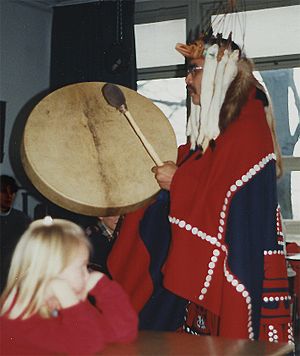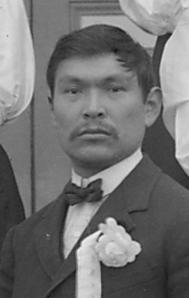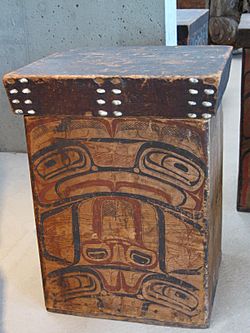Tsimshian facts for kids

Tsimshian drumming in 1999
|
|
| Total population | |
|---|---|
| 8,162 | |
| Regions with significant populations | |
| Canada British Columbia |
5,910 |
| United States Alaska |
2,252 |
| Languages | |
| English • Coast Tsimshian | |
The Tsimshian ( Tsimshian: Ts’msyan) are an indigenous people of the Pacific Northwest Coast. Their communities are mostly in coastal British Columbia and far southern Alaska, around Terrace and Prince Rupert in British Columbia, and Alaska's Annette Islands.
The Tsimshian people consist of approximately 10,000 members of seven First Nations (including the Kitselas, Kitsumkalum, and the "Allied Tribes" of the Lax Kw'Alaams; the Metlakatla, Kitkatla, Gitga'at at Hartley Bay, and Kitasoo at Klemtu). The Tsimshian are one of the largest First Nations peoples in northwest British Columbia. Some Tsimshian migrated to Annette Island, Alaska, and today approximately 1,450 Alaska Tsimshian people are enrolled in the federally recognized Metlakatla Indian Community, sometimes also called the Annette Island Reserve.
Tsimshian society is kinship-based and matrilineal, so clans and property pass through the maternal line. Their moiety-based societal structure is further divided into clans.
Early Euro-Canadian anthropologists and linguists had classified the Gitxsan and Nisga'a as Tsimshian, because of apparent linguistic affinities. The three were all referred to as "Coast Tsimshian," even though some communities were not coastal. These three groups, however, are separate nations.
Contents
History
Tsimshian translates to "Inside the Skeena River." At one time the Tsimshian lived on the upper reaches of the Skeena River near present-day Hazelton, British Columbia. The majority of Tsimshian still live in the lower Skeena River watershed near [Prince Rupert], as well as northern coastal BC.
According to southern Tsimshian oral history, after a series of disasters befell the people, a chief led a migration away from the cursed land to the coast, where they founded Kitkatla Village, the first of three Southern Tsimshian villages. Kitkatla is still considered to be the most conservative of the Tsimshian villages. The Nisga'a and Gitxsan remained in the upper Skeena region (above the canyon) near the Nass River and forks of the Skeena respectively, but other Tsimshian chiefs moved down the river and occupied all the lands of the lower Skeena valley. Over time, these groups developed a new dialect of their ancestral language and came to regard themselves as a distinct population, the Tsimshian-proper. They continued to share the rights and customs of those who are known as the Gitxsan, their kin on the upper Skeena.
In late precontact times, the Coastal Tsimshian gradually moved their winter villages out to the islands of Venn (Metlakatla). They returned to their summer villages along the lower Skeena River when the salmon returned. Archaeological evidence shows 5,000 years of continuous inhabitation in the Prince Rupert region.
Kitkatla was probably the first Tsimshian village contacted by Europeans when Captain Charles Duncan and James Colnett arrived in 1787. Although Captain George Vancouver sailed up the Portland Canal into Nisga'a territory in 1793, the Gitksan were not subject to settlement pressure until the confluence of the Skeena and Bulkley Rivers, formerly the site of the Tsimshian village of Kitanmaks, became the new European settlement of Skeena Forks (today known as Hazelton). When the Hudson's Bay Company moved their fort to modern-day Port Simpson in 1834, nine Tsimshian villages moved to the surrounding area. Many of the Tsimshian peoples in Canada still live in these regions.
Throughout the second half of the 19th century, epidemics of infectious disease contracted from Europeans ravaged their communities, as the First Nations had no acquired immunity to these diseases. The 1862 Pacific Northwest smallpox epidemic killed many of the Tsimshian people. Altogether, one in four Tsimshian died in a series of at least three large-scale outbreaks.
In 1835, the total population of the Tsimshian peoples was estimated at 8,500. By 1885, the population had dropped to 4,500, 817 of whom moved to Alaska two years later.
In the 1880s the Anglican missionary William Duncan, along with a group of the Tsimshian, left Metlakatla, British Columbia and requested settlement on Annette Island from the U.S. government. After gaining approval, the group founded New Metlakatla on Annette Island in southern Alaska. Duncan appealed to Congress to grant the community reservation status, which it did in the late 19th century.
In 1895, the BC Tsimshian population stood at 3,550, while the Alaska Tsimshian population had dropped to 465 by 1900. After this low-water point, the Tsimshian population began to grow again, eventually to reach modern numbers comparable to the 1835 population estimate. However, the numbers of the inland Tsimshian peoples are now higher than they were historically, while those of the Southern and Coastal Tsimshian are much lower.
In the 1970s, the Metlakatla Indian Community voted to retain their rights to land and water, and opted out of the Alaska Native Claims Settlement Act (ANCSA); they have the only Native reservation in Alaska. The residents of Arctic Village and Venetie accepted free and simple title to the land within the Venetie reservation boundaries, while all other tribes participated in ANCSA.
The Metlakatla Tsimshian maintained their reservation status and holdings exclusive of the Alaska Native Claims Settlement Act. They do not have an associated Native Corporation, although Tsimshian in Alaska may be shareholders of the Sealaska Corporation. The Annette Islands Reserve is the only location in Alaska allowed to maintain fish traps according to their traditional treaty rights. The use of these were otherwise banned when Alaska became a state in 1959. The traps are used to gather fish for food for people living on the reservation. Legally the community was required to use the traps at least once every three years or lose the right permanently. They stopped the practice early in the 2000s and lost their right to this traditional way of fishing.
Culture

The Tsimshian have a matrilineal kinship system, with a societal structure based on a clan system, properly referred to as a moiety. Descent and property are figured through the maternal line. Hereditary chiefs gained their rights through their maternal line and could be deposed by women's elders.
The marriage ceremony was an extremely formal affair, several prolonged and sequential ceremonies. Some cultural taboos have related to prohibiting women and men from eating improper foods during and after childbirth.
Like all Northwest Coastal peoples, the Tsimshian harvested the abundant sea life, especially salmon. The Tsimshian became seafaring people, like the Haida. Salmon continues to be at the center of their nutrition, despite large-scale commercial fishing in the area. Due to this abundant food source, the Tsimshian developed permanent towns. They lived in large longhouses, made from cedar house posts and panels to withstand the wet climate. These were very large and usually housed an entire extended family.
Tsimshian religion centered on the "Lord of Heaven," who aided people in times of need by sending supernatural servants to earth to aid them. The Tsimshian believed that charity and purification of the body (either by cleanliness or fasting) was the route to the afterlife.
In common with Northwest Coastal peoples, the Tsimshian engage in the potlatch, which they refer to as the yaawk (feast). Today in Tsimshian culture, the potlatch is held at gatherings to honour deaths, burials, and succession to name-titles.
The Tsimshian have maintained their art and culture, and are working to revitalize the use of their language. Historically, the Tsimshian competed with the Tlingit, Haida, the Athapaskan groups in the north and east, and the Wakashan groups in the south.
Ethnobotany
Like other coastal peoples, the Tsimshian fashioned most of their goods out of western red cedar, especially its bark. It could be fashioned into tools, clothing, roofing, armour, building materials, and canoe skins. They used cedar in their Chilkat weaving, which they are credited with inventing. They use the berries of Vaccinium Vitis-idaea ssp. minus as food.
Tribes
The Tsimshian people of British Columbia encompass fifteen tribes:
- Gitasts'uu, Gidisdzu or Kitasoo (″(People of) a large, tiered house-depression″, together with the Xai'xais, a Heiltsuk group from Kynoch Inlet they are part of the Kitasoo/Xaixais First Nation at Klemtu (Klemdulxk / Xłmduulxk), British Columbia)
- Gitḵ'a'ata, Gitga'ata or Gitga'at ("People of the Cane", as Hartley Bay Indian Band at Hartley Bay (Txałgiu / Txałgiiw), British Columbia)
- Gitxaała, Gitxaala oder Kitkatla (″People of the Open Sea″, also known as Git lax m’oon (″People of the saltwater″), as Gitxaala Nation they live in the village of Kitkatla (La̱x Klan), British Columbia)
- Gitsumkalum (Kitsumkalum, British Columbia)
- Gits'ilaasü or Kitselas (Kitselas, British Columbia)
- Allied tribes of Lax Kw'alaams (Port Simpson, British Columbia) including Metlakatla
- Metlakatla, Alaska newest tribe, with lineages from all Tsimshian tribes
Clans
The Tsimshian clans are the
- Laxsgiik (Eagle Clan)
- Gispwudwada (Killer Whale Clan)
- Ganhada (Raven Clan)
- Laxgibuu (Wolf Clan)
Treaty process
The Tsimshian wanted to preserve their villages and fishing sites on the Skeena and Nass Rivers as early as 1879. They were not able to begin negotiating a treaty with the Canadian government until July 1983. A decade later, fourteen bands united to negotiate under the collective name of the Tsimshian Tribal Council. A framework agreement was signed in 1997. The Tsimshian nation continues to negotiate with the BC Treaty Commission to reach an Agreement-in-Principle.
Language
The Tsimshian speak a language, called Sm'algyax, which translates as "real or true tongue." The Tsimshian also speak a language variety similar to Gitxsan and Nisga’a (two inland Tsimshianic languages), but differentiated from the regional Tsimshian variations. In 2016, only 160 people in Canada were Tsimshian speakers.
Some linguists classify Tsimshian languages as a member of the theoretical Penutian language group.
Notable Tsimshian people

- Frederick Alexcee, artist
- William Beynon, Gitlaan and ethnographer
- David A. Boxley, Laxsgiik, carver and culture bearer. First to host a potlatch and raise a totem pole in modern times in Metlakatla, Alaska
- Marcia Crosby, art historian
- Alfred Dudoward, hereditary chief of the Gitando, and leader of the Port Simpson Methodist Movement. co-founder of the Native Brotherhood
- Benjamin Haldane, pioneering photographer from Metlakatla village
- William Jeffrey, Gitwilgyoats, hereditary chief, activist, carver
- Rudy Kelly, author and journalist
- Paul Legaic, hereditary chief of the Gispaxlo'ots and trader.
- Odille Morison, translator and art collector
- Rev. William Henry Pierce, missionary and memoirist
- Peter Simpson, Native American rights activist
- Phil Gray, artist
- Henry W. Tate, Gispakloats, oral historian, tribal headman
- Roy Henry Vickers, artist
- Arthur Wellington Clah, from the house of Tamks of the Gispaxlo'ots. Translator at Fort Simpson, the first to teach Father Duncan the Sm`algyax language, diarist
- Walter Wright; hereditary chief of the Gits'ilaasü (Kitselas) and oral historian
Anthropologists and other scholars who have worked with the Tsimshian
- Marius Barbeau
- William Beynon
- Franz Boas
- Philip Drucker
- Wilson Duff
- Viola Garfield
- René Girard
- Marjorie Halpin
- Charles Menzies
- Jay Miller
Missionaries who attempted to convert the Tsimshian
- William Henry Collison
- Thomas Crosby, Methodist
- William Duncan Anglican/independent
- Edward Marsden, Presbyterian
- Bishop William Ridley Anglican
- Robert Tomlinson, Anglican
See also
 In Spanish: Tsimshian para niños
In Spanish: Tsimshian para niños


